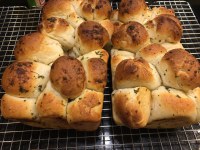Prairie Fare: 6 Dogs Taught Me Some Health Lessons
(Click an image below to view a high-resolution image that can be downloaded)
“Jake, do not hurt Abby,” I said to one of our dachshunds.
Jake and I locked eyes. I think he winked at me. He had most of Abby’s head in his mouth, like a lion with its prey.
By the way, Abby is a year-old dachshund pup we nicknamed “Miss Abby the Troublemaker.”
“She was pestering me,” I could almost hear Jake say.
I watched him gently immobilize the younger dog. Obviously he knew she is a dachshund and not a rabbit from our backyard.
Jake released Abby. She immediately rolled onto her back and slid under Jake’s body to nip him in the belly again. Poor Jake. Being a dog with short legs is challenging sometimes.
I think I heard Jake sigh. He trotted away, found an isolated corner and burrowed into the blankets.
During the recent holidays, our three dachshunds were joined by our friend’s three dachshunds while he vacationed in another state. Yes, we had six lively wiener dogs running around some areas of our house for two weeks. I felt like the mother of six toddlers who required ongoing attention.
I especially enjoyed relaxing with six dogs on our couch, with a fuzzy blanket, roaring fire in our fireplace and a movie. We were safe from the blizzard outside. Dogs emit a lot of heat. I fell asleep.
We humans are rewarded by the companionship of dogs and other pets in many ways. In the process, I learned a few lessons from our furry pack.
- Lesson 1: Go outside and play. Yes, you can find ways to get exercise, even in the winter.
Dogs are experts in playing and they usually are very happy to run outside and chase balls, rabbits or squirrels. The six dachshunds looked like porpoises leaping through snowdrifts in our backyard.
We also had lots of playful activity going on inside our house, including dog wrestling between Abby and Chester or Jake or Louie, with Toby as the referee.
We humans can enjoy the snow by snowshoeing, cross-country skiing and skating in the winter. Snow shoveling also counts as physical activity. If the temperatures are too cold, venture to a gym or mall, or try doing indoor exercises to a DVD or online video.
Remember: We adults need 30 minutes of moderate physical activity on most days of the week, so vary your activity and find a buddy to keep you motivated.
- Lesson 2. Relax and get your needed rest. Dogs are happy to nap, but we humans sometimes are too stressed to get the sleep we need. Being around animals can lower your blood pressure.
According to the Centers for Disease Control and Prevention, adults need seven to nine hours of sleep per day. To get the sleep you need, be sure your bedroom is quiet, dark and relaxing, and the temperature is right for you - not too warm or too cold.
Stay on a schedule and avoid computer or phone screens before sleep. Do something relaxing, such as reading or listening to music before going to bed. Be aware of your body’s reaction to caffeine and alcohol because both can affect sleep.
- Lesson 3. Watch your food intake, especially treats. I actually taught the dogs this lesson as
I became a “dietitian for dachshunds.” When the guest pets arrived, I asked our friend if I could trim their portions. Their dachshund bellies were getting closer to the floor than was good for their backs and overall health. Two of the older dogs were moving slowly.
We trimmed their food portions to about two-thirds of the original and gave them small carrots as treats. Our dogs learned to be happy with a pat on the head or having their ears scratched instead of a dog biscuit.
Trimming food intake and increasing activity worked for the dogs, just as it does for humans. Without prompting from me, their owner immediately noticed Lilly’s and Toby’s new-found waistlines and increased energy.
If you have (or have had) pets, you probably can think of many more lessons you have learned. Dogs are loyal creatures with unique personalities. They can help maintain your heart health, help with weight management, reduce stress and help prevent depression. Having children grow up around pets can boost their immune system and help prevent allergies.
Here’s one of the recipes we tried during our holiday break. The dogs didn’t share in any of it. Dogs need to stay with a diet designed for dogs. Along with garlic, dogs should not eat onions, raisins, chocolate and several other foods. Check with your veterinarian for more information about their care and feeding.
Visit https://www.ag.ndsu.edu/food to check out our nutrition, food safety and health information. Sign up for free newsletters, and register for our free “Field to Fork” gardening webinars launching in February.
Pull-apart Garlic Bubble Loaves
2 packages (1/4 ounce each) active dry yeast (3 1/2 tsp.)
1/4 c. warm water (110 degrees)
2 c. warm milk (110 degrees)
2 Tbsp. sugar
1 Tbsp. butter, melted
2 tsp. salt
6 1/4 to 6 1/2 cups all-purpose flour (add gradually)
1/2 cup butter, melted
1 Tbsp. dried parsley flakes
2 tsp. garlic powder
To add fiber, substitute 2 to 3 cups of whole-wheat flour for all-purpose flour.
In a large mixing bowl, dissolve yeast in warm water. Add the milk, sugar, 1 tablespoon butter, salt and 2 cups flour; beat until smooth. Stir in enough remaining flour to form a soft dough. Place dough on a floured surface and knead until smooth and elastic, about five minutes. Place in a greased bowl, turning once to grease top. Cover and let rise in a warm place until doubled, about one hour. Punch dough down. Turn onto a lightly floured surface; divide the dough into four pieces. Divide each portion into 12 pieces to make 48 dough balls. In a shallow bowl, combine 1/2 cup melted butter, parsley and garlic powder. Shape each piece of dough into a ball; dip into butter mixture. Place in two greased 9- by 5- by 3-inch loaf pans. Cover and let rise until doubled, about 30 minutes. Preheat oven to 375 degrees. Bake for 35 to 40 minutes, until golden brown. Cool for 10 minutes. Remove from pans to wire racks. Serve warm.
Makes 24 servings (two small “buns” per serving). A serving has 170 calories, 4.5 grams (g) fat, 4 g protein, 27 g carbohydrate, 1 g fiber and 240 milligrams sodium.
(Julie Garden-Robinson, Ph.D., R.D., L.R.D., is a North Dakota State University Extension food and nutrition specialist and professor in the Department of Health, Nutrition and Exercise Sciences. Follow her on Twitter @jgardenrobinson)
NDSU Agriculture Communication - Jan. 10. 2019
| Source: | Julie Garden-Robinson, 701-231-7187, julie.garden-robinson@ndsu.edu |
|---|---|
| Editor: | Ellen Crawford, 701-231-5391, ellen.crawford@ndsu.edu |




